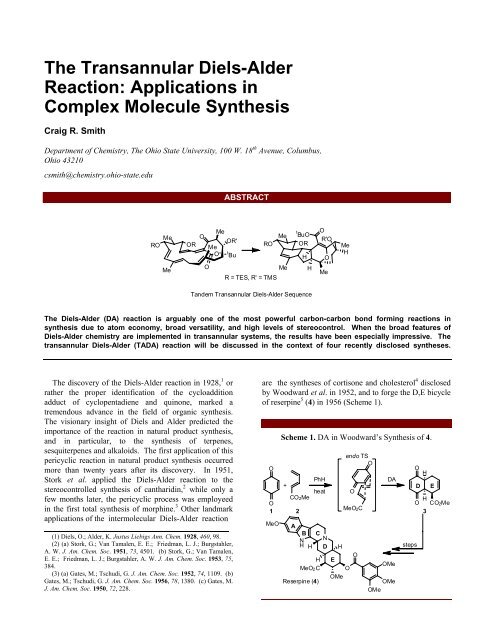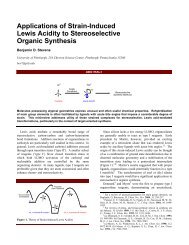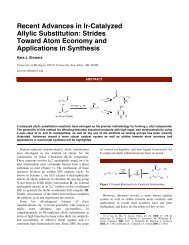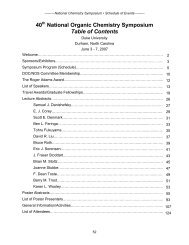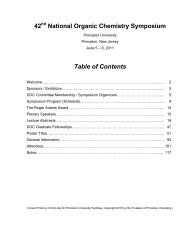The Transannular Diels-Alder Reaction - ACS Organic Division
The Transannular Diels-Alder Reaction - ACS Organic Division
The Transannular Diels-Alder Reaction - ACS Organic Division
You also want an ePaper? Increase the reach of your titles
YUMPU automatically turns print PDFs into web optimized ePapers that Google loves.
<strong>The</strong> <strong>Transannular</strong> <strong>Diels</strong>-<strong>Alder</strong><br />
<strong>Reaction</strong>: Applications in<br />
Complex Molecule Synthesis<br />
Craig R. Smith<br />
Department of Chemistry, <strong>The</strong> Ohio State University, 100 W. 18 th Avenue, Columbus,<br />
Ohio 43210<br />
csmith@chemistry.ohio-state.edu<br />
Me<br />
RO<br />
ABSTRACT<br />
<strong>The</strong> <strong>Diels</strong>-<strong>Alder</strong> (DA) reaction is arguably one of the most powerful carbon-carbon bond forming reactions in<br />
synthesis due to atom economy, broad versatility, and high levels of stereocontrol. When the broad features of<br />
<strong>Diels</strong>-<strong>Alder</strong> chemistry are implemented in transannular systems, the results have been especially impressive. <strong>The</strong><br />
transannular <strong>Diels</strong>-<strong>Alder</strong> (TADA) reaction will be discussed in the context of four recently disclosed syntheses.<br />
<strong>The</strong> discovery of the <strong>Diels</strong>-<strong>Alder</strong> reaction in 1928, 1 or<br />
rather the proper identification of the cycloaddition<br />
adduct of cyclopentadiene and quinone, marked a<br />
tremendous advance in the field of organic synthesis.<br />
<strong>The</strong> visionary insight of <strong>Diels</strong> and <strong>Alder</strong> predicted the<br />
importance of the reaction in natural product synthesis,<br />
and in particular, to the synthesis of terpenes,<br />
sesquiterpenes and alkaloids. <strong>The</strong> first application of this<br />
pericyclic reaction in natural product synthesis occurred<br />
more than twenty years after its discovery. In 1951,<br />
Stork et al. applied the <strong>Diels</strong>-<strong>Alder</strong> reaction to the<br />
stereocontrolled synthesis of cantharidin, 2 while only a<br />
few months later, the pericyclic process was employeed<br />
in the first total synthesis of morphine. 3 Other landmark<br />
applications of the intermolecular <strong>Diels</strong>-<strong>Alder</strong> reaction<br />
e<br />
(1) <strong>Diels</strong>, O.; <strong>Alder</strong>, K. Justus Liebigs Ann. Chem. 1928, 460, 98.<br />
(2) (a) Stork, G.; Van Tamalen, E. E.; Friedman, L. J.; Burgstahler,<br />
A. W. J. Am. Chem. Soc. 1951, 73, 4501. (b) Stork, G.; Van Tamalen,<br />
E. E.; Friedman, L. J.; Burgstahler, A. W. J. Am. Chem. Soc. 1953, 75,<br />
384.<br />
(3) (a) Gates, M.; Tschudi, G. J. Am. Chem. Soc. 1952, 74, 1109. (b)<br />
Gates, M.; Tschudi, G. J. Am. Chem. Soc. 1956, 78, 1380. (c) Gates, M.<br />
J. Am. Chem. Soc. 1950, 72, 228.<br />
Me<br />
O<br />
O t OR<br />
Me<br />
OR'<br />
Me<br />
Bu<br />
O<br />
RO<br />
R=TES,R'=TMS<br />
are the syntheses of cortisone and cholesterol 4 disclosed<br />
by Woodward et al. in 1952, and to forge the D,E bicycle<br />
of reserpine 5 (4) in 1956 (Scheme 1).<br />
Scheme 1. DA in Woodward’s Synthesis of 4.<br />
O<br />
endo TS<br />
O<br />
O<br />
H<br />
PhH<br />
DA<br />
+<br />
heat O<br />
D E<br />
O<br />
1<br />
CO2Me<br />
2<br />
MeO2C<br />
H<br />
O CO2Me<br />
3<br />
MeO<br />
Me<br />
t BuO<br />
OR<br />
Me H<br />
Tandem <strong>Transannular</strong> <strong>Diels</strong>-<strong>Alder</strong> Sequence<br />
H<br />
O<br />
R'O<br />
O<br />
Me<br />
Me<br />
H<br />
A<br />
B<br />
N<br />
H H<br />
C<br />
N<br />
D H<br />
H E<br />
O<br />
MeO2C O<br />
Reserpine (4)<br />
OMe<br />
OMe<br />
OMe<br />
OMe<br />
steps
As intermolecular variations of the DA have been<br />
employed in a number of syntheses, more recent<br />
endevours have used the intramolecular DA with great<br />
efficiency. Here, the benefit is that the product outcome<br />
can be predicted with high accuracy due to the<br />
stereochemical requirements of the pre-existing<br />
functionalities. <strong>The</strong> power of the DA was again<br />
demonstrated by Corey et al. in a brilliant synthesis of<br />
gibberellic acid, 6 in which a chemo- and regioselective<br />
intermolecular DA introduced the relative<br />
stereochemistry in the B and C rings of the final product,<br />
followed by an intramolecular substrate-controlled DA to<br />
forge the A ring of gibberellic acid.<br />
Deslongchamps envisioned that a TADA would<br />
possess high chemo-, regio-, and diastereoselectivity. It<br />
would also generate highly complex carbocyclic systems<br />
as a result of both entropic activation and conformational<br />
restraints in the macrocyclic environment. His seminal<br />
work in the area layed the foundation for future synthetic<br />
endevours, four of which will be examined in detail.<br />
Deslongchamps influential contributions include TADA<br />
reactions of 13-membered macrocyclic trienones, 7 TADA<br />
reactions of 14-membered macrocycles, 8 dienedienophile<br />
reactivity studies for the TADA, 9 and the<br />
synthesis of a number of natural products including<br />
cassaine A (5) 10 and aphidicolin (6, Figure 1). 11<br />
Deslonchamps noted, 12 “…the complexity and power of<br />
HO<br />
H<br />
Figure 1. Cassaine A and Aphidicolin.<br />
H<br />
O<br />
O<br />
Cassaine A (5)<br />
O<br />
N<br />
HO<br />
HO<br />
H<br />
Aphidicolin (6)<br />
the TADA strategy arises from a judicious choice of<br />
substituents that will govern the conformation adopted by<br />
the macrocycle at the transition state level, via<br />
transannular steric repulsion and electronic interactions,”<br />
or more plainly, an in-depth analysis of the macrocycle<br />
and the potential transition states leads to a high fidelity<br />
e<br />
(4) Woodward, R. B.; Sondheimer, F.; Taub, D.; Heusler, K.;<br />
McLamore, W. M. J. Am. Chem. Soc. 1952, 74, 4223.<br />
(5) (a) Woodward, R. B.; Bader, F. E.; Bickel, H.; Frey, A. J.;<br />
Kierstead, R. W. J. Am. Chem. Soc. 1956, 78, 2023. (b) Woodward, R.<br />
B.; Bader, F. E.; Bickel, H.; Frey, A. J.; Kierstead, R. W. J. Am. Chem.<br />
Soc. 1956, 78, 2657.<br />
(6) (a) Corey, E. J.; Danheiser, R. L.; Chandrasekaran, S.; Siret, P.;<br />
Keck, G. E.; Gras, J.-L. J. Am. Chem. Soc. 1978, 100, 8031. (b) Corey,<br />
E. J.; Danheiser, R. L.; Chandrasekaran, S.; Keck, G. E.; Gopalan, B.;<br />
Larsen, S. D.; Siret, P.; Gras, J.-L. J. Am. Chem. Soc. 1978, 100, 8034.<br />
(7) (a) Baettig, K.; Dallaire, C.; Pitteloud, R.; Deslongchamps, P.<br />
Tetrahedron Lett. 1987, 28, 5249. (b) Baettig, K.; Marinier, A.;<br />
Pitteloud, R.; Deslongchamps, P. Tetrahedron Lett. 1987, 28, 5253. (c)<br />
Bérubé, G.; Deslongchamps, P. Tetrahedron Lett. 1987, 28, 5255.<br />
(8) (a) Lamothe, S.; Ndibwani, A.; Deslongchamps, P. Tetrahedron<br />
Lett. 1988, 29, 1641. (b) Marinier, A.; Deslongchamps, P. Tetrahedron<br />
Lett. 1988, 29, 6215.<br />
OH<br />
OH<br />
prediction of the stereocontrolled assembly of densely<br />
populated carbocyclic arrays.<br />
Recently, a number of biologically and structurally<br />
interesting carbocyclic natural products have been<br />
assembled via the TADA reaction including (+)-<br />
FR182877, (+)-macquaramicin A, (-)-spinosyn A, and<br />
(+)-superstolide A. Among these compounds, (+)-<br />
FR182877 is interesting as it possesses a highly oxygen<br />
and carbon functionalized hexacyclic core, 12 stereogenic<br />
centers, and significant microtubule stabilizing activity.<br />
In 2001, Sorensen and co-workers 13 suggested that 11<br />
Me<br />
R'O<br />
Scheme 2. Sorensen’s Synthesis of (+)-FR182877.<br />
Bu t O2C<br />
RO<br />
CO 2Me<br />
O<br />
1. PhSeBr<br />
2. mCPBA<br />
Me<br />
OR<br />
OR<br />
Pd2dba3<br />
R=TES<br />
R' = TMS<br />
Bu t O2C<br />
Me<br />
R'O<br />
Me<br />
Me<br />
Me<br />
7 8<br />
Me<br />
Me<br />
RO<br />
O<br />
O t OR<br />
Me<br />
OR'<br />
Me<br />
Bu<br />
O<br />
Me<br />
9 and (Z)-isomer<br />
Me<br />
H<br />
H<br />
OR<br />
H<br />
H CO2Bu<br />
H<br />
O<br />
Me<br />
OR'<br />
t<br />
Me<br />
H<br />
steps<br />
H<br />
Me<br />
H<br />
OH<br />
H<br />
H O<br />
H<br />
O O<br />
H<br />
Me<br />
Me<br />
10 (+)-FR182877 (11)<br />
O<br />
HO<br />
Me<br />
CHCl3<br />
40°C<br />
may arise from a polyunsaturated linear biosynthetic<br />
intermediate that undergoes a cascade of intramolecular<br />
reactions. To date, Sorensen’s synthesis 14 (Scheme 2) of<br />
(+)-FR182877 is the supreme expression of the TADA in<br />
action. <strong>The</strong> synthesis of the key 19-membered<br />
macrocyclic precursor culminated, after 16 steps, with a<br />
palladium-mediated Tsuji-Trost reaction. Heating the<br />
macrocycle in CHCl3 at 40°C induced the sequential<br />
TADA and hetero-TADA reactions that stereoselectively<br />
e<br />
(9) (a) Cantin, M.; Xu, Y.-C.; Deslongchamps, P. Can. J. Chem.<br />
1990, 68, 2144. (b) Roberge, J. Y.; Giguere, P.; Soucy, P.; Dory, Y. L.;<br />
Deslongchamps, P. Can. J. Chem. 1994, 72, 1820.<br />
(10) Pheonix, S.; Bourque, E.; Deslongchamps, P. Org. Lett. 2000, 2,<br />
4149.<br />
(11) (a) Bélanger, G.; Deslongchamps, P. Org. Lett. 2000, 2, 285. (b)<br />
Bélanger, G.; Deslongchamps, P. J. Org. Chem. 2000, 65, 7070.<br />
(12) Deslongchamps, P. Pure & Appl. Chem. 1992, 64, 1831.<br />
(13) (a) Vanderwal, C. D.; Vosburg, D. A.; Weiler, S.; Sorensen, E. J.<br />
Org. Lett. 1999, 1, 645. (b) Vanderwal, C. D.; Vosburg, D. A.;<br />
Sorensen, E. J. Org. Lett. 2001, 3, 4307.<br />
(14) Vosburg, D. A.; Vanderwal, C. D.; Sorensen, E. J. J. Am. Chem.<br />
Soc. 2002, 124, 4552.<br />
Me<br />
OR<br />
OR<br />
Me
fashioned 10 as a single diastereomer. In a single step,<br />
the overall process generated a pentacyclic structure with<br />
concomitant installation of seven contiguous stereogenic<br />
centers in 40% isolated yield. Most notably, this work<br />
elicited the first example of a tandem or sequential<br />
TADA reaction, which highlights the utility of the TADA<br />
in complex molecule synthesis. As Deslongchamps<br />
eluded to previously, the capacity of the tandem reaction<br />
is governed by entropic and enthalpic activation in the<br />
macrocycle with product geometry determined by<br />
transannular repulsion and electronic interactions in the<br />
transition state of the pericyclic reaction. Shortly after<br />
Sorensen’s disclosure of (+)-FR182877, both Evans 15 and<br />
Sorensen 13 published syntheses of the natural enantiomer,<br />
(-)-FR182877, both utilizing TADA strategies.<br />
<strong>The</strong> macquarimicins are a polyketide based class of<br />
natural products that are comprised of a cistetrahydroindanone<br />
ring, a β-keto-δ-lactone, and a 10membered<br />
carbocycle. Biologically, these compounds<br />
MeO 2CO<br />
MeO<br />
Scheme 3. Synthesis of (+)-Macquarimicin A.<br />
Me<br />
MPMO<br />
Pd 2dba 3<br />
MeO2C<br />
OR<br />
O O OR OR R=TBS<br />
O<br />
12 13<br />
H<br />
Me<br />
steps<br />
H<br />
H<br />
O<br />
HO<br />
steps<br />
Me OMPM<br />
OR<br />
Me<br />
OMPM<br />
H<br />
O<br />
BHT<br />
toluene<br />
130°C<br />
H<br />
H<br />
OMPM<br />
H<br />
H<br />
O<br />
O O<br />
H<br />
O<br />
OH<br />
14<br />
O<br />
H<br />
15<br />
H<br />
H H Me<br />
O<br />
O<br />
O<br />
HO<br />
H H<br />
(+)-Macquarimicin A (16)<br />
exhibit selective inhibition of neutral sphingomyelinase<br />
and antiinflammatory activity. Inspired by a series of<br />
enzymatic reactions, 16 Tadano and co-workers achieved<br />
the total synthesis of (+)-macquarimicin A (Scheme 3) by<br />
implementing a late stage TADA reaction to assemble<br />
three of the four rings found in the natural product. <strong>The</strong><br />
acyclic polyene precursor to the macrocycle was<br />
assembled via a Stille reaction of an (E)-vinyliodide and a<br />
(Z)-vinylstannane. <strong>The</strong> 17-membered macrocycle was<br />
e<br />
(15) Evans, D. A.; Starr, J. T. Angew. Chem. Int. Ed. 2002, 41, 1787.<br />
(16) Munakata, R.; Katakai, H.; Ueki, T.; Kurosaka, J.; Takao, K.;<br />
Tadano, K. J. Am. Chem. Soc. 2003, 125, 14722.<br />
closed by an intramolecular Tsuji-Trost reaction. Under<br />
thermal conditions, 14 underwent TADA smoothly to<br />
form a single diastereomer without event. <strong>The</strong> E,Z<br />
geometry of the diene (14) is most likely the origin of<br />
the spectacular endo-selectivity, 17 as only one endo<br />
transition state is free of steric and transannular<br />
interactions. Tadano and co-workers further elaborated<br />
Scheme 4. Synthesis of (+)-Macquarimicin B & C.<br />
(+)-16<br />
Me<br />
H<br />
HO<br />
O<br />
O<br />
MeO<br />
H<br />
H<br />
O<br />
OH<br />
H<br />
Me<br />
Me<br />
H<br />
(+)-Macquarimicin B (18)<br />
O<br />
MeO<br />
Me<br />
H<br />
O H<br />
H<br />
O<br />
CSA<br />
O<br />
OH<br />
17<br />
H<br />
Me<br />
H<br />
H<br />
Me<br />
O<br />
O<br />
O<br />
O<br />
O<br />
H<br />
H<br />
H<br />
H<br />
Me<br />
H<br />
O<br />
(+)-Macquarimicin C (19)<br />
16 (Scheme 4) via an intermolecular hetero-DA reaction<br />
via transcient pentacyclic intermediate 17 to afford (+)macquarimicin<br />
B (18). Furthermore, treatment of 18 with<br />
CSA lead to (+)-macquarimicin C (19) via an<br />
intramolecular dehydrative alkylation.<br />
<strong>The</strong> highly insecticidal spinosyns have attracted much<br />
synthetic attention in the past decade. Notably, total<br />
syntheses of (-)-spinosyn A have been completed by both<br />
Evans 18 and Paquette. 19 <strong>The</strong> (-)-spinosyn A structure<br />
contains a key 12-membered lactone fused to the 5,6,5cis-anti-trans<br />
carbocyclic ring system. It has been<br />
proposed that the biogenesis of (-)-spinosyn A 20 involves<br />
a late stage TADA followed by a nucleophile induced<br />
transannular Michael cyclization. Recently, Roush and<br />
co-workers, 21 finished (-)-spinosyn A (24, Scheme 5) by<br />
treating 20 with iPr2NEt and LiCl in MeCN expecting<br />
formation of 21, but the macrocyclization conditions in<br />
reality afforded TADA product 22 in 75% isolated yield<br />
as a mixture of diastereomers. Presumably, cycloadduct<br />
e<br />
(17) (a) Dineen, T. A.; Roush, W. R. Org. Lett. 2003, 5, 4725. (b)<br />
Paquette, L. A.; Chang, J.; Liu, Z. J. Org. Chem. 2004, 69, 6441.<br />
(18) Evans, D. A.; Black, W. C. J. Am. Chem. Soc. 1993, 115, 4497.<br />
(19) (a) Paquette, L. A.; Gao, Z.; Ni, Z.; Smith, G. F. J. Am. Chem.<br />
Soc. 1998, 120, 2543. (b) Paquette, L. A.; Collado, I.; Purdie, M. J. Am.<br />
Chem. Soc. 1998, 120, 2553.<br />
(20) (a) Oikawa, H.; Tokiwano, T. Nat. Prod. Rep. 2004, 21, 321.<br />
(b) Kim, H. J.; Pongdee, R.; Wu, Q.; Hong, L.; Liu, H.-W. J. Am. Chem.<br />
Soc. 2007, 129, 14582.<br />
(21) (a) Mergott, D. J.; Frank, S. A.; Roush, W. R. Proc. Natl. Acad.<br />
Sci. U.S.A. 2004, 101, 11955. (b) Winbush, S. A.; Mergott, D. J.;<br />
Roush, W. R. J. Org. Chem. 2008, 73, 1818.
22 arose from the tandem macrocyclization-TADA<br />
process with good selectivity, which was driven by the<br />
Scheme 5. <strong>The</strong> TADA in the synthesis of (-)-Spinosyn A.<br />
Rham<br />
O<br />
RhamO<br />
RhamO<br />
H<br />
Br<br />
steps<br />
Br<br />
Br<br />
21<br />
O<br />
20<br />
O<br />
O<br />
Me<br />
O<br />
P<br />
O<br />
OPMB<br />
Et<br />
(OEt)2<br />
Me OPMB<br />
O<br />
O<br />
Et H<br />
O<br />
iPr2NEt, LiCl<br />
MeCN, 23°C<br />
OPMB<br />
Me<br />
Rham<br />
Me<br />
O<br />
O<br />
Me3P<br />
O<br />
O Et<br />
H<br />
H H<br />
22<br />
Br<br />
23<br />
Me<br />
O<br />
O<br />
Me<br />
OMe<br />
OMe Me<br />
O O<br />
O<br />
O<br />
O<br />
O Et<br />
H H<br />
(-)-SpinosynA (24)<br />
75%<br />
(ds = 73:12:9:6)<br />
OPMB<br />
O<br />
O<br />
O<br />
NMe2<br />
Me<br />
conformational preference of the C6-brominated<br />
macrocycle in the TADA. <strong>The</strong> division of the remaining<br />
15-membered macrocycle to complete the tetracyclic core<br />
was achieved via a transannular vinylogous Morita-<br />
Baylis-Hillman reaction to afford cycloadduct 23.<br />
Installation of the forosamine unit completed (-)-spinosyn<br />
A in 31 linear steps in a three percent overall yield from<br />
readily available materials.<br />
(+)-Superstolide A (28) is a member of a class of<br />
structurally unique macrolides isolated from Neosiphomia<br />
superstes. 22 <strong>The</strong> superstolides exhibit highly cytotoxic<br />
activity toward a number of cancer cell lines including<br />
murine P388 leukemia cells. Roush 23 and co-workers’<br />
critical step in the synthesis of 28 (Scheme 6) was a late<br />
stage TADA used to segment the 24-membered<br />
macrocycle into the tricyclic core of the natural product.<br />
Treatment of 25 with Pd(PPh3)4 and TlOEt realized an<br />
e<br />
(22) (a) D’Auria, M. V.; Debitus, C.; Paloma, L. G.; Minale, L.;<br />
Zampella, A. J. Am. Chem. Soc. 1994, 116, 6658.<br />
(23) Tortosa, M.; Yakelis, N. A.; Roush, W. R. J. Am. Chem. Soc.<br />
2008, 130, 2722<br />
(24) Balskus, E. P.; Jacobsen, E. N. Science, 2007, 317, 1736.<br />
Et<br />
intramolecular Suzuki-Miyaura coupling to afford the 24-<br />
membered macrocyle. Macrocycle 26 underwent a highly<br />
Scheme 6. <strong>The</strong> Roush Synthesis of (+)-Superstolide A.<br />
TBDPSO<br />
MeO<br />
25<br />
TBDPSO<br />
O<br />
O<br />
B<br />
I<br />
Me<br />
Me<br />
O<br />
Me O<br />
O<br />
Me<br />
O<br />
Me<br />
O<br />
Me<br />
MeO<br />
Me<br />
Me<br />
O<br />
26<br />
Me<br />
Me Me<br />
Me<br />
NBoc<br />
NBoc<br />
TBDPSO<br />
H<br />
Me<br />
Me<br />
Me<br />
MeO O<br />
H<br />
NBoc<br />
O<br />
27<br />
Me Me<br />
Me<br />
O<br />
Suzuki<br />
80°C, 2 h,<br />
toluene<br />
steps<br />
NH2OCO<br />
H<br />
Me<br />
Me<br />
Me<br />
MeO<br />
H<br />
OH<br />
NHAc<br />
O<br />
(+)-Superstolide A (28)<br />
Me Me<br />
Me<br />
O<br />
regio- and diastereoselective TADA reaction to yield 27<br />
as the only observed cycloadduct. Moreover, this<br />
example reinforces Deslonchamps conclusions that the<br />
conformation of the macrocycle in the transition state,<br />
which is governed by transannular and electronic<br />
interactions, dictates the product outcome in the TADA.<br />
Sequential treatment of 27 with TBAF, trichloroacetyl<br />
isocyanate, and removal of the acetonide and Boc<br />
protecting groups, followed by an acylation of the<br />
primary amine afforded the desired product, (+)superstolide<br />
A (28).<br />
<strong>The</strong>se examples verify the power of the TADA to<br />
generate complex arrays of densely populated cyclic<br />
structures, which is the most significant feature of this<br />
methodology. Future work on the TADA most likely will<br />
include the development of ligand-controlled highly<br />
enantio- and diastereoselective variants 24 and potentially<br />
tandem TADA/1,3-dipolar cycloaddition reactions to<br />
generate highly functionalized heterocyclic arrays. As<br />
natural product targets become more complex, one should<br />
expect to see the full potential of the TADA unveiled.


